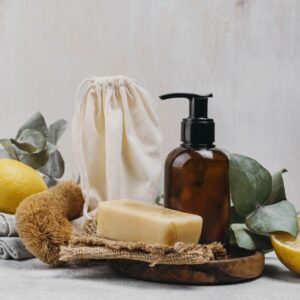When you walk past the shelf of skin care products, you may be overwhelmed by a simple choice: liquid soap or bar soap? Both have loyal fans who say they are gentle and keep your skin clean. But which choice is really better for your skin?
At YouWish, we know that soap isn’t just for washing. It’s also about how your skin feels after using it, the ingredients you trust and even the little things you do in your bathroom. In this blog, we discuss the differences between liquid soap and bar soap, the benefits of using natural soap and even how to make liquid soap at home so you know exactly what you’re putting on your skin.
What makes soap into soap?
Let’s go back to basics before comparing the two forms. When oils or fats are mixed with a strong alkali, such as lye, soap is created. This process is called saponification and the result is a cleansing product that can remove dirt, oil and bacteria from the skin.
- Soap in bar form is usually the direct result of this process, in which oils, lye and water are cured into a solid form.
- Liquid soap often contains additional water, glycerin and stabilizers to keep it in a pourable form.
The science is simple, but the details of how it is made are important. A bar of soap can feel creamy and nourishing if it contains rich oils, or it can feel harsh and drying if it contains synthetic detergents. Similarly, liquid soap can be gentle if it contains glycerin and natural extracts, but can also dry out the skin if it contains a lot of sulfates. Natural soap makes all the difference when it comes to ingredients. You can choose between a simple bar of soap or a pump bar, but the difference is in the ingredients.
Soap in bar form: the classic choice
The benefits
Soap in bar form has been around for hundreds of years for a reason. It’s easy to use, works well and can be full of healthy oils and butters. Some natural soap bars contain ingredients such as olive oil, shea butter or coconut oil that leave skin soft and moisturized.
Another big plus is that it lasts a long time. The packaging of most pieces of soap can be recycled or composted, so you’re not contributing to the plastic problem. They are also highly concentrated, so what you buy consists mainly of active ingredients and not water. As a result, pieces of soap not only last longer, but also have a smaller impact on the environment when stored and transported.
You can make pieces of soap for different purposes, such as exfoliating soap with ground seeds, soothing soap with oatmeal or invigorating blends with citrus oils. A single piece of natural soap can do more than just cleanse; it can turn your routine into a ritual and show that you care.
The disadvantages
But not everyone can use pieces of soap. Some ordinary pieces of soap can dry out the skin because they have a higher pH, which can damage the skin barrier if you use them too often. If the soap is cheaply made with artificial fragrances or synthetic cleansers, it can cause irritation, especially in people with eczema or sensitive skin.
There is also the issue of hygiene. Although research shows that bacteria do not live long on a bar of soap, people still worry about sharing it. A bar of soap can become mushy or slimy if it is not in a soap dish where water can drain out. This makes it less pleasant to use. Soap in pieces can also be less convenient for people who travel a lot, unless kept in a pouch.
The bottom line? If you choose a bar of soap, make sure it’s a good soap, and if possible, a natural soap. That way you won’t have to worry about extra chemicals and you can enjoy all the moisturizing benefits of oils and butters.
Liquid soap: the modern favorite
The benefits
In recent decades, liquid soap has become increasingly popular. This is mainly because it feels nice and is easy to use. A pump bottle makes hand washing and showering faster and less messy for many people.
Liquid soap often contains additional moisturizers, such as glycerin or aloe vera. This makes the soap feel softer and more moisturizing. Dermatologists sometimes recommend liquid cleansers for people with sensitive or dry skin because its pH can be adjusted to match that of the skin.
Another advantage is that there are many different types. Liquid soaps come in a wider range of scents and textures than bars of soap. For example, they can be silky smooth or foamy. Many people like to make their bathroom experience unique by choosing different liquid soaps for their hands, face and body. You can really make everything to your liking when you add the ability to make liquid soap at home.
The disadvantages
Yet liquid soap also has disadvantages. The most obvious disadvantage is packaging. Most liquid soaps are sold in plastic bottles, which contributes to waste unless you actively use refill options. They are also less concentrated than bars of soap, which means you pay more for water content and shipping weight.
From a financial standpoint, liquid soap runs out faster, especially in households where several people use the same pump. And unless you choose a natural soap, many liquid soaps contain synthetic stabilizers, preservatives or artificial fragrances that can irritate the skin.
While liquid soap often feels more modern and luxurious, it is important to look beyond the packaging and check the ingredients to make sure you are really buying a product that is both good for your skin and for the environment.
Which is better for the health of your skin?
Dermatologists often say it depends when they get this question. Your skin type, lifestyle and even the weather can affect how your skin reacts to soap.
- Dry or sensitive skin: Many people prefer liquid soap because it tends to be less alkaline and often contains moisturizing ingredients such as glycerin.
- Oily or acne-prone skin: A properly formulated natural soap with purifying ingredients such as activated charcoal, clay or tea tree oil can help balance excess sebum.
- Environmentally conscious users: Soap in bar form is generally the greener option thanks to minimal packaging and longer life.
There is no one option that is better for everyone. Rather, think of it as a series. A moisturizing liquid soap may be the best choice if your skin feels tight or flaky after washing. A natural soap may be the best choice for you if you care about the environment and like a thick, foaming lather.
Why natural soap is worth it
The list of ingredients really determines whether a soap works well and is gentle, no matter what form you prefer. Natural soap does not contain harsh chemicals, detergents or additional fillers. Instead, it cleanses the skin without damaging the barrier by using saponified vegetable oils and nourishing botanical ingredients.
Olive oil, for example, contains antioxidants and creates a creamy lather. Coconut oil, on the other hand, helps form lather and has antibacterial properties. Essential oils can add fragrance and health benefits, while shea butter deeply moisturizes. When you choose natural soap, your daily wash does more than just remove dirt; it also gives your skin nutrients.
There are many soaps on the market that are full of chemicals and strong fragrances, but natural soap is a mild, eco-friendly and skin-friendly choice. It can change the feel of your skin and reduce the risk of irritation, whether you use it as a bar of soap or liquid soap.
How to make liquid soap at home
Making liquid soap at home is fun for people who like to be in charge. You can choose everything, from the oils you use to the fragrances you add. Your homemade soap can be 100% natural, biodegradable and made specifically for your skin, unlike many soaps you buy at the store.
Here is a simple overview:
- Choose your oils: olive oil for nourishment, coconut oil for lather, almond or jojoba oil for a silky feel.
- Make the lye solution: Use potassium hydroxide (KOH) instead of sodium hydroxide (NaOH), which is used for pieces of soap.
- Saponification process:Mix the oils with the lye solution until they are completely emulsified and a thick paste forms.
- Dilute with water: Slowly add water to transform the paste into a smooth, pourable liquid.
- Add extras: essential oils, herbal infusions or glycerin for extra moisture and fragrance.
Learning how to make liquid soap is great because it gives you freedom. Want a shower gel that smells like lavender? Then add some essential lavender oil. Need something to kill bacteria in the kitchen? Then try eucalyptus or tea tree oil. If you make your own soap, you can be sure you’re using real, natural soap without extra chemicals.
Environmental considerations
It’s no longer just about how your soap feels, but how it affects the environment.
- Soap in bar form is usually the better choice for the environment. It has a much smaller carbon footprint because it requires less packaging material and water and is easier to transport. One bar of natural soap wrapped in paper creates much less waste than a lot of plastic pump bottles.
- Liquid soap usually comes in more packages and requires more energy to transport it. But refill stations and zero-waste stores make it easier to buy lots of liquid soap and reuse the same containers. You can reduce even more waste by making liquid soap at home and reusing bottles. Just make sure your recipe is biodegradable.
Ultimately, the choices you make not only affect your skin, but also the environment. By choosing eco-friendly, natural marine ingredients and being conscious about packaging, you are taking steps toward a more sustainable lifestyle.
Frequently asked questions: liquid soap versus bar soap
V1. Is liquid soap cleaner than bar soap?
Yes, using pump bottles for liquid soap reduces cross-contamination. However, studies show that pieces of soap stored properly do not pose much risk when used correctly.
V2. Which lasts longer: liquid soap or bar soap?
Bar soap usually lasts longer and is cheaper. Liquid soap may run out faster, but is easier to use and comes in more scents.
V3. Is it easy to make liquid soap at home?
Yes. Anyone can learn to make liquid soap at home with the right ingredients. You can also add natural oils and fragrances to make your own version.
V4. Is natural soap always better for your skin?
Yes, for most people. Natural soap does not contain synthetic detergents, but it does contain oils that are good for and protect your skin.
V5. Is liquid soap or bar soap better for dry skin?
Liquid soap is often better because it contains extra moisturizers, but a good natural soap with shea butter and other nourishing ingredients can also help with dry skin.
Conclusion: the right soap for you
So which is better for your skin: liquid soap or bar soap? The truth is that both can be excellent if you focus on natural soap formulations and choose what suits your skin type and lifestyle.
- If you like convenience and a gentler pH, choose liquid soap.
- If you want minimal packaging and longevity, a bar of natural soap may be your best friend.
- And if you want complete control, why not learn how to make liquid soap at home?
At YouWish, we offer the ingredients and inspiration to help you make soap that’s good for your skin and kind to the environment. Whether you’re looking for natural soap bases or want to discover how to make your own liquid soap, we’re here to guide you on your DIY skincare journey.

